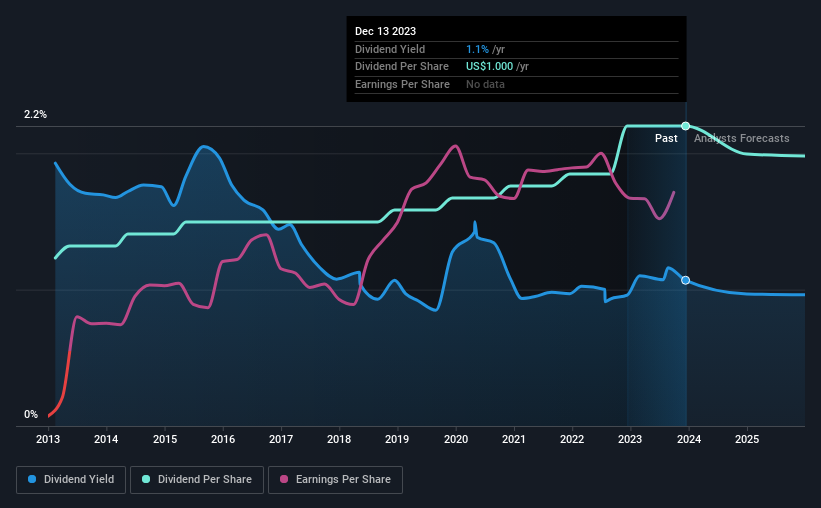- United States
- /
- Machinery
- /
- NYSE:AIN
Albany International's (NYSE:AIN) Upcoming Dividend Will Be Larger Than Last Year's

The board of Albany International Corp. (NYSE:AIN) has announced that it will be increasing its dividend by 4.0% on the 8th of January to $0.26, up from last year's comparable payment of $0.25. Even though the dividend went up, the yield is still quite low at only 1.1%.
See our latest analysis for Albany International
Albany International's Dividend Is Well Covered By Earnings
Even a low dividend yield can be attractive if it is sustained for years on end. Before making this announcement, Albany International was easily earning enough to cover the dividend. This means that most of its earnings are being retained to grow the business.
The next year is set to see EPS grow by 66.4%. Assuming the dividend continues along recent trends, we think the payout ratio could be 20% by next year, which is in a pretty sustainable range.

Albany International Has A Solid Track Record
The company has been paying a dividend for a long time, and it has been quite stable which gives us confidence in the future dividend potential. The dividend has gone from an annual total of $0.56 in 2013 to the most recent total annual payment of $1.00. This implies that the company grew its distributions at a yearly rate of about 6.0% over that duration. The dividend has been growing very nicely for a number of years, and has given its shareholders some nice income in their portfolios.
The Dividend Has Growth Potential
Some investors will be chomping at the bit to buy some of the company's stock based on its dividend history. It's encouraging to see that Albany International has been growing its earnings per share at 7.5% a year over the past five years. With a decent amount of growth and a low payout ratio, we think this bodes well for Albany International's prospects of growing its dividend payments in the future.
Albany International Looks Like A Great Dividend Stock
In summary, it is always positive to see the dividend being increased, and we are particularly pleased with its overall sustainability. The company is easily earning enough to cover its dividend payments and it is great to see that these earnings are being translated into cash flow. Taking this all into consideration, this looks like it could be a good dividend opportunity.
Investors generally tend to favour companies with a consistent, stable dividend policy as opposed to those operating an irregular one. Meanwhile, despite the importance of dividend payments, they are not the only factors our readers should know when assessing a company. Earnings growth generally bodes well for the future value of company dividend payments. See if the 4 Albany International analysts we track are forecasting continued growth with our free report on analyst estimates for the company. Is Albany International not quite the opportunity you were looking for? Why not check out our selection of top dividend stocks.
New: Manage All Your Stock Portfolios in One Place
We've created the ultimate portfolio companion for stock investors, and it's free.
• Connect an unlimited number of Portfolios and see your total in one currency
• Be alerted to new Warning Signs or Risks via email or mobile
• Track the Fair Value of your stocks
Have feedback on this article? Concerned about the content? Get in touch with us directly. Alternatively, email editorial-team (at) simplywallst.com.
This article by Simply Wall St is general in nature. We provide commentary based on historical data and analyst forecasts only using an unbiased methodology and our articles are not intended to be financial advice. It does not constitute a recommendation to buy or sell any stock, and does not take account of your objectives, or your financial situation. We aim to bring you long-term focused analysis driven by fundamental data. Note that our analysis may not factor in the latest price-sensitive company announcements or qualitative material. Simply Wall St has no position in any stocks mentioned.
About NYSE:AIN
Albany International
Engages in the machine clothing and engineered composites businesses.
Flawless balance sheet average dividend payer.
Similar Companies
Market Insights
Community Narratives




